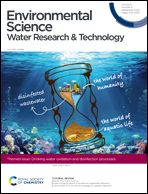Tracking the formation of new brominated disinfection by-products during the seawater desalination process†
Abstract
Several areas around the world rely on seawater desalination to meet drinking water needs, but a detailed analysis of dissolved organic matter (DOM) changes and disinfection by-product (DBP) formation due to chlorination during the desalination processes has yet to be evaluated. To that end, DOM composition was analyzed in samples collected from a desalination plant using bulk measurements (e.g. dissolved organic carbon, total dissolved nitrogen, total organic bromine), absorbance and fluorescence spectroscopy, and ultrahigh resolution mass spectrometry (HRMS). Water samples collected after chlorination (e.g. post pretreatment (PT), reverse osmosis (RO) reject (brine wastewater) (BW), RO permeate (ROP), and drinking water (DW)), revealed that chlorination resulted in decreases in absorbance and increases in fluorescence apparent quantum yield spectra. All parameters measured were low or below detection in ROP and in DW. However, total solid phase extractable (Bond Elut Priority PolLutant (PPL) cartridges) organic bromine concentrations increased significantly in PT and BW samples and HRMS analysis revealed 392 molecular ions containing carbon, hydrogen, oxygen, bromine (CHOBr) and 107 molecular ions containing CHOBr + sulfur (CHOSBr) in BW PPL extracts. A network analysis between supposed DBP precursors suggested that the formation of CHOBr formulas could be explained largely by electrophilic substitution reactions, but also HOBr addition reactions. The reactions of sulfur containing compounds are more complex, and CHOSBr could possibly be due to the bromination of surfactant degradation products like sulfophenyl carboxylic acids (SPC) or even hydroxylated SPCs. Despite the identification of hundreds of DBPs, BW did not show any acute or chronic toxicity to mysid shrimp. High resolution MS/MS analysis was used to propose structures for highly abundant bromine-containing molecular formulas but given the complexity of DOM and DBPs found in this study, future work analyzing desalination samples during different times of year (e.g. during algal blooms) and during different treatments is warranted.

- This article is part of the themed collection: Drinking water oxidation and disinfection processes


 Please wait while we load your content...
Please wait while we load your content...